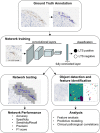Antemortem detection of Parkinson's disease pathology in peripheral biopsies using artificial intelligence
- PMID: 35164870
- PMCID: PMC8842941
- DOI: 10.1186/s40478-022-01318-7
Antemortem detection of Parkinson's disease pathology in peripheral biopsies using artificial intelligence
Abstract
The diagnosis of Parkinson's disease (PD) is challenging at all stages due to variable symptomatology, comorbidities, and mimicking conditions. Postmortem assessment remains the gold standard for a definitive diagnosis. While it is well recognized that PD manifests pathologically in the central nervous system with aggregation of α-synuclein as Lewy bodies and neurites, similar Lewy-type synucleinopathy (LTS) is additionally found in the peripheral nervous system that may be useful as an antemortem biomarker. We have previously found that detection of LTS in submandibular gland (SMG) biopsies is sensitive and specific for advanced PD; however, the sensitivity is suboptimal especially for early-stage disease. Further, visual microscopic assessment of biopsies by a neuropathologist to identify LTS is impractical for large-scale adoption. Here, we trained and validated a convolutional neural network (CNN) for detection of LTS on 283 digital whole slide images (WSI) from 95 unique SMG biopsies. A total of 8,450 LTS and 35,066 background objects were annotated following an inter-rater reliability study with Fleiss Kappa = 0.72. We used transfer learning to train a CNN model to classify image patches (151 × 151 pixels at 20× magnification) with and without the presence of LTS objects. The trained CNN model showed the following performance on image patches: sensitivity: 0.99, specificity: 0.99, precision: 0.81, accuracy: 0.99, and F-1 score: 0.89. We further tested the trained network on 1230 naïve WSI from the same cohort of research subjects comprising 42 PD patients and 14 controls. Logistic regression models trained on features engineered from the CNN predictions on the WSI resulted in sensitivity: 0.71, specificity: 0.65, precision: 0.86, accuracy: 0.69, and F-1 score: 0.76 in predicting clinical PD status, and 0.64 accuracy in predicting PD stage, outperforming expert neuropathologist LTS density scoring in terms of sensitivity but not specificity. These findings demonstrate the practical utility of a CNN detector in screening for LTS, which can translate into a computational tool to facilitate the antemortem tissue-based diagnosis of PD in clinical settings.
Keywords: Artificial intelligence; Convolutional neural network; Deep learning; Machine learning; Parkinson’s disease; Peripheral biopsy; Submandibular gland; Synucleinopathy; Whole slide image.
© 2022. The Author(s).
Conflict of interest statement
Bahram Marami, Marcel Prastawa, Mary Sawyer, Israel Duran, John Koll, Gerardo Fernandez, Jack Zeineh, and Carlos Cordon-Cardo disclose their relationship with PreciseDx™, an artificial intelligence-guided pathology diagnostics company, which has developed proprietary platform and AI algorithms used in this study.
Figures





References
-
- (2016) Systemic synuclein sampling study s4: biospecimen collection, processing, and shipment manual. https://michaeljfox.Org/Files/S4_Biologics_Manual_Version_2.Pdf
-
- Adler CH, Beach TG, Hentz JG, Shill HA, Caviness JN, Driver-Dunckley E, Sabbagh MN, Sue LI, Jacobson SA, Belden CM, et al. Low clinical diagnostic accuracy of early vs advanced Parkinson disease: clinicopathologic study. Neurology. 2014;83:406–412. doi: 10.1212/Wnl.0000000000000641. - DOI - PMC - PubMed
Publication types
MeSH terms
Grants and funding
LinkOut - more resources
Full Text Sources
Medical

